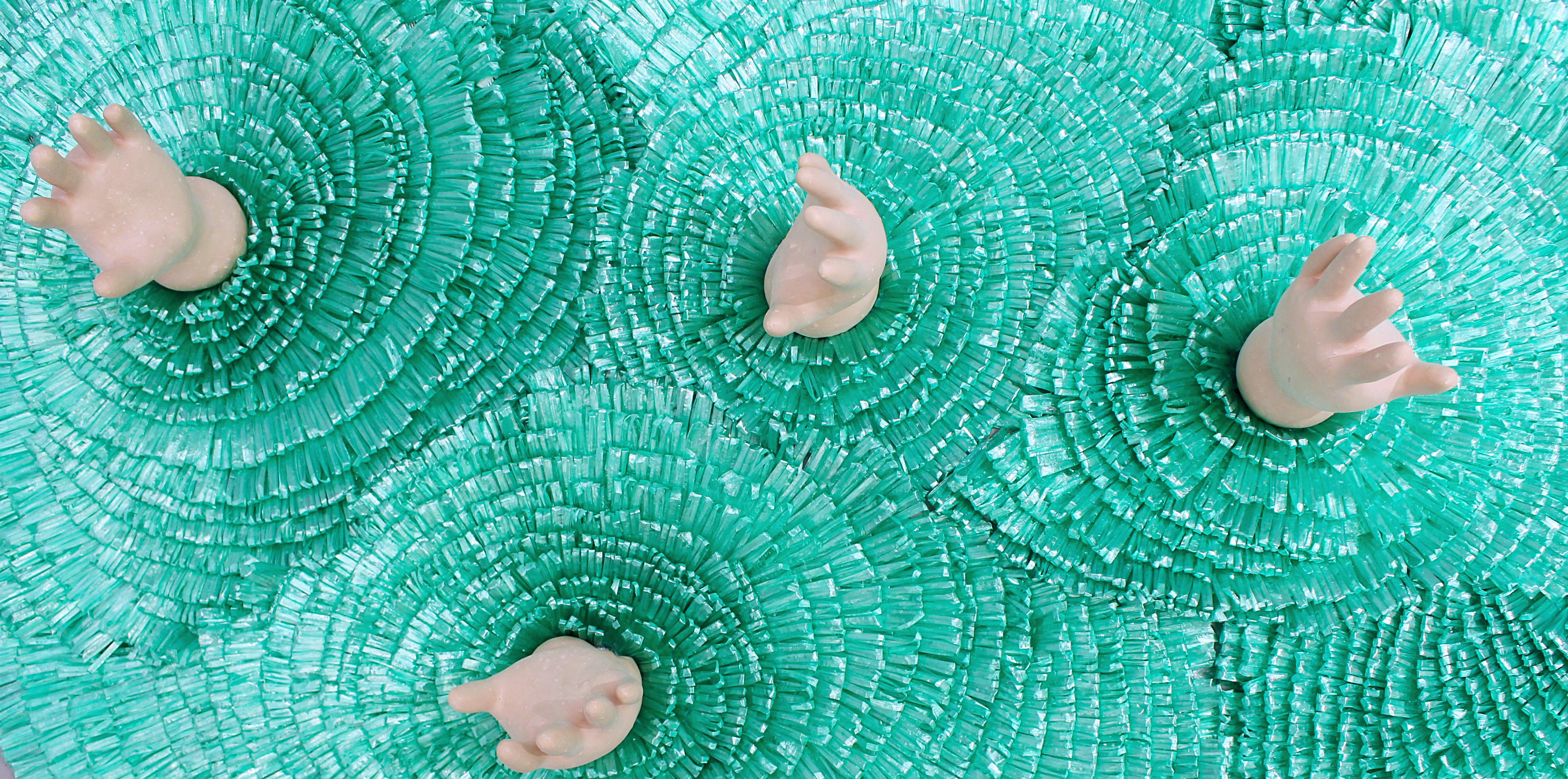Causality and synchronicity
Risa Tsunegi | 常木理早
4 February – 1 April 2019
Opening night reception with + publication launch: 4 February , 19:30 – 21:30
Bubbly reception by Jacob’s Creek
|
How are we to recognize acausal combinations of events, since it is obviously impossible to examine all chance happenings for their causality? The answer to this is that acausal events may be expected most readily where, on closer reflection, a causal connection appears to be inconceivable. — Carl G. Jung, Synchronicity: An Acausal Connecting Principle (共時性:非因果的連関の原理), Princeton University Press, 1960 常木理早のThe Containerでの新しい展覧会、『Causality and synchronicity』は、偶然のように思われる考えや、行動に直結する出来事において因果関係によって促される連想関係を探求しています。偶然と非因果の間にあるこの哲学的な緊張は、常木が人固有の身体および脳機能という観点から、美しさと人間性というテーマ、そして現実逃避によりそれら現実の紛らわしと気晴らしを探るヒントとなっています。 常木の立体作品の制作は、よく知られたありふれたものを詩的に再びカスタマイズすることで、身体的および心理的に期待に反し知覚を疑う新たなものやインスタレーションを生み出し、身近な日常の素材に新しい意味をもたらすという、彼女の概念的な意向に特徴づけられています。常木の作品はいつも皮肉とユーモアをもって驚きと予期せぬ結果を招きます。 『Causality and synchronicity』では、見たところ因果関係なしに生じ、それでも意味ありげに関係しているような出来事へのそれぞれの興味に結び付けてられた、二種類の作品を発表します。それら作品は、祈りと憧れ、瞑想、そしてフェティッシュにおいて、人体の美しさとその機能を考察しています。 この展覧会でのメインとなる立体作品「Swimming in the Grass」(2018)は、一般的な緑の梱包用ビニール紐を縫ってできた輪を慎重に組立てた芝の中に浮腫んだ手足がそっと漂う、大きなミックスドメディアの床に設置された作品です。常木の形成した円形パターンは、水面の振動または波紋を想起させます – 摂動はその手足の流れるような動きによって引き起こされたようです。 手足は恐らく予想外の気圧の変化や長い一日の疲れのせいで不自然に膨張し、膨大になり、そして癒しと安らぎという形をとった遊び心のある動きでゆっくりと芝の中に沈んでいきます。食べ物や飲み物の残留物である塩分と水分によって肥大化し、一日の疲労により増すむくんだ体の芝への進入は柔らかく、計画的です。常木によれば、シンクロナイズドスイミングをしている様 – 計算され、エレガントでそして悠然としています。 人体の美しさと体の反応(腫れ)へのこの関心は、この作品の中で常木にとって鍵となり、そして自然なふるまいに隠された美においての伝統的な日本の哲学的信念に続いています。この作品は、東京の混雑した電車の中でたまたま彼女の向かい側に浮腫んだ足をして座っていた見知らぬ人にインスピレーションを得ました。彼女は『それを素敵なものだと思い、人生の美しさを感じた』と言っています。 「Swimming in the Grass」は、茶色の包装紙に描かれた一連のコンセプトドローイングを伴っています。これらのドローイングは、彫刻作品における波状のパターンの習作として作成され、手足が芝の中に沈んだり出たりする際、また、風によって、もしくは芝と接触した人、動物や物が残した痕跡によって、そのパターンがどのように変化するのかを考察したものです。これらのドローイングは、常木がダイナミックでいて静止した質感を表現するための様々な手段を模索することを目的としており、完成された作品に見るシンクロナイズドスイミングのパフォーマンスにおける柔らかな動きを静寂の触媒としました。 これらの作品に加えて、『Causality and synchronicity』では、The Containerのために制作されたインタラクティブな作品、「Wish Whip」(2019)を展示します。この作品は、神社の祭壇のそばに通例設置されている鈴の緒からインスピレーションを得ています。神社では、祈る前にその端についている鐘を鳴らすために紐を振ります。鐘の音は、神を呼び覚まし、そして祈り捧げる者が祈願する前に浄化するためと信じられています。それは、祈るという主たる行為の前の準備において、最後の行為です。鈴の緒は、目的を遂行する前の最終ステップの誘因として、日本では結びつけて考えられます。 「Wish Whip」において、常木は動物を拘束するために使用されるか、またはフェティッシュの場面における大人のおもちゃとして使用される、革で編まれたブルウイップに関連的参照をしています。この作品は、ギャラリーの建物に準じて作成され、三つの鞭として現れています。短い二つ(赤と灰色)は天井に固定され、三つ目の長めのもの(黒)は、金属製の管システムを介して空間の入口に繋がっています。長い方の鞭を引くと、ベル音の代わりに金属製の筒の中からふわふわした素材のものが飛び出します。 この立体作品は、未来の出来事の前触れとして観客が行動を起こして作品とふれあうことを促します。変化を促すためには物理的に行動を起こさなければならないという信念体系、つまり、ある人の行動は世の中の他の出来事に影響を及ぼし良き変化に貢献するだろう、という考えに導かれています。 |
How are we to recognize acausal combinations of events, since it is obviously impossible to examine all chance happenings for their causality? The answer to this is that acausal events may be expected most readily where, on closer reflection, a causal connection appears to be inconceivable.
— Carl G. Jung, Synchronicity: An Acausal Connecting Principle, Princeton University Press, 1960 Risa Tsunegi’s new exhibition at The Container, Causality and synchronicity, explores associative connections between notions that seem coincidental and between occurrences that relate directly to action, facilitated through cause and effect. This philosophical tension between the casual and acasual helps Tsunegi to explore ideas of beauty and nature in context of humans’ innate bodily and cerebral functions, and the distraction and relief of those realities through escapism. Tsunegi’s sculptural practice is defined by her conceptual premeditation on how to bring new meanings to familiar everyday materials, where poetic recustomization of the known and banal gives birth to new objects and installation displays that challenge perception, and defy physical and mental expectations. Tsunegi’s works always arouse a surprise, an unexpected outcome—treated often with irony and humor. Causality and synchronicity showcases two separate bodies of works, linked by their interest in events that apparently occur with no causal relationship, yet seem to be meaningfully related. The works examine the beauty of the human body and its functions, among prayer and longing, meditation, and fetish. The main sculptural piece the exhibition is featuring, Swimming in the Grass (2018), is a large mixed-media floor installation showcasing swollen limbs, delicately flowing in grass that was painstakingly constructed by stitched rings of standard green plastic packaging thread. The circular patterns Tsunegi formed recall undulation, or ripples, on a water’s surface—perturbation precipitated by the flowing movement of the limbs. The limbs are unnaturally distended, bloated, perhaps due to unexpected pressure or a long tiring day, slowly sinking into the grass in a playful motion of ease, as a form of healing and relief. The plunge into the grass is soft and premeditated, lubricated by salinity and moisture, by grease collected throughout a day of working, mixed with residue of food and drink. In Tsunegi’s mind, the limbs are performing synchronized swimming in a calculated, elegant, and deliberate fashion. This preoccupation in the beauty of the human body and its reactions (swelling), is key to Tsunegi in this piece, and follows traditional Japanese philosophical beliefs about beauty hidden in natural processes. Her inspiration for the piece derived from a chance encounter with a stranger seated across from her on one of Tokyo’s notoriously busy trains, with swollen legs: “I saw it as something lovely and I felt the beauty of life,” she explicates. Swimming in the Grass is accompanied by a series of concept drawings on brown packaging paper. These drawings were produced as studies for the undulation pattern of the complete sculptural piece, examining how the pattern may change when a limb sinks into the grass or comes out of it, perhaps disturbed, at times, by the wind or by traces of activity of other humans, animals and objects that came to contact with it. The drawings intend to explore the various means Tsunegi can achieve a texture that is both dynamic and static and were the catalyst for the calm, soft movements she likened to a synchronized swimming performance that we see in the finished sculpture. Along with those works, Causality and synchronicity also exhibits an additional interactive sculptural piece, Wish Whip (2019), designed especially for The Container. The sculpture draws inspiration from Shinto shrines, specifically the bell cord that is typically found by the altar. Before praying in a shrine, one shakes the cord to ring a bell that is attached to its end. The bell sound is believed to rouse the gods and to purify the prayer before invoking. It is the last action one takes in preparation before the main act of praying. The bell cord is associated in Japan as a trigger before taking the last step before performing a task. In Wish Whip, Tsunegi makes associative references to plaited leather bull whips, used to restrain an animal or used as a sex toy in a fetish setting. The sculpture, which was designed to emulate the architecture of the gallery, sees a set of three whips—two shorter ones (red and grey), fixed to the ceiling; and a third longer one (black) that is connected through a system of metal tubing to the entrance of the space. Upon pulling on the long whip, instead of a bell sound, a fluffy material pops out of the metal tube. The sculpture encourages visitors to take action and interact with the piece, serving as a precursor to future events. It follows the belief system that in order to facilitate a change, one must physically take action: one’s conduct would affect other occurrences in the universe, and would contribute for a positive change. |

